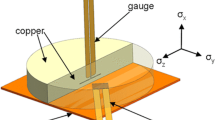Abstract
This paper touches upon a question of whether the physical state of shock-compressed copper is equilibrium. Answering this question requires that experimental data on defective electrical resistance are used to estimate point defect concentration. Quantitative information on the concentration of defects can be obtained if the type of occurring defects is known. A dependence between defect concentration in copper and a shock wave pressure is obtained in an assumption of the predominant formation of vacancies. It is shown that the number of defects monotonically increases with increasing shock wave pressure. The vacancy concentration calculated in this study (≈0.8% at a pressure of 20 GPa) exceeds the corresponding equilibrium value by ten orders of magnitude. Thus, the state of copper under shock compression is highly defective and highly nonequilibrium. The general features of the state of copper and silver are described by comparing data for shock-compressed metals. As demonstrated by comparing the data obtained immediately after the passage of a shock wave through a sample (in situ) with the known results for samples recovered after the experiment, the number of recorded defect concentrations in the first case is larger (up to two orders of magnitude). Thus, the method of stored samples does not provide objective information on the state of substance directly behind the shock front. The problem of constructing the equation of state under conditions of a nonequilibrium physical state is briefly discussed.


Similar content being viewed by others
REFERENCES
Ya. B. Zel’dovich and Yu. P. Raizer, Physics of Shock Waves and High-Temperature Hydrodynamic Phenomena (Nauka, Moscow, 1966; Dover, 2002).
V. N. Zharkov and V. A. Kalinin, Equations of State fpr Solids at High Pressures and Temperatures (Nauka, Moscow, 1968; Consultants Bureau, 1971).
A. V. Bushman and V. E. Fortov, “Model Equations of State," Usp. Fiz. Nauk 140 (2), 177–232 [Sov. Phys. Usp.26 465 (1983)].
Shock Waves and Extreme States of Matter, Ed. by V. E. Fortov, L. V. Al’tshuler, R. F. Trunin, and A. I. Funtikova (Nauka, Moscow, 2000) [in Russian].
S. Eliezer, A. Ghatak, and H. Hora, Fundamentals of Equations of State (World Scientific, Singapore, 2002).
V. E. Fortov, Thermodynamics and Equations of State for Matter: From Ideal Gas to Quark-Gluon Plasma (WSPC, 2016).
I. V. Lomonosov and S. V. Fortova, “Wide-Range Semiempirical Equations of State of Matter for Numerical Simulation on High-Energy Processes," Teplofiz. Vys. Temp. 55 (4), 596–626 (2017) [High Temp. 55 (4), 585–610 (2017)].
R. F. Trunin, L. F. Gudarenko, M. V. Zhernokletov, and G. V. Simakov, Experimental Data on Shock Compression and Adiabatic Expansion of Condensed Matter (All-Russian Scientific Research Institute of Experimental Physics (VNIIEF), Sarov, 2006) [in Russian].
S. B. Kormer, “Optical Study of the Characteristics of Shock-Compressed Condensed Dielectrics," Usp. Fiz. Nauk94 (4), 641–687 (1968) [Sov. Phys. Usp. 11, 229 (1968)].
R. A. Graham, Solids under High-Pressure Shock Compression (Springer-Verlag, New York, 1993).
M. A. Meyers, Dynamic Behavior of Materials (John Wiley and Sons, New York, 1994).
Physical Metallurgy, Ed. by R. W. Cahn and P. Haasen (North Holland, 1996).
I. Kovács and H. E. Sayed, “Point Defects in Metals," J. Mater. Sci. 11 (3), 529–559 (1976).
R. A. Graham, “Active Measurements of Defect Processes in Shock-Compressed Metals and Other Solids," in Shock Waves and High-Strain-Rate Phenomena in Metals, Ed. by M. Meyers (Plenum Press, New York, 1981).
H. Kressel and N. Brown, “Lattice Defects in Shock-Deformed and Cold-Worked Nickel," J. Appl. Phys. 38 (4), 1618 (1967); https://doi.org/10.1063/1.1709733.
D. C. Brillhart, A. G. Preban, and P. Gordon, “The Annealing of Explosively Deformed Copper," Metall. Trans. 1 (4), 969–978 (1970).
M. A. Mogilevskii, “Structural Changes in Pure Copper Subjected to Explosive Loading," Fiz. Goreniya Vzryva 6 (2), 224–229 (1970) [Combust., Expl., Shock Waves 6 (2), 197–201 (1970)].
A. M. Podurets, M. I. Tkachenko, O. N. Ignatova, et al., “Dislocation Density in Copper and Tantalum Subjected to Shock Compression Depending on Loading Parameters and Original Microstructure," Fiz. Metal. Metalloved. 114 (5), 480–487 (2013) [Phys. Met. Metallogr. 114 (5), 440–447 (2013)].
S. B. Kormer, M. V. Sinitsyn, G. A. Kirillov, and L. T. Popova, “An Experimental Determination of the Light Absorption Coefficient in Shock-Compressed NaCl. The Absorption and Conductivity Mechanism," Zh. Eksp. Teor. Fiz. 49 (1), 135–147 (1966) [J. Exp. Theor. Phys. (U.S.S.R.) 49, 135–147 (1965)].
V. V. Yakushev, “Electrical Measurements in a Dynamic Experiment," Fiz. Goreniya Vzryva 14 (2), 3–19 (1978) [Combust., Expl., Shock Waves 14 (2), 131–146 (1978)].
S. D. Gilev, “Measurement of Electrical Conductivity of Condensed Substances in Shock Waves (Review)," Fiz. Goreniya Vzryva47 (4), 3–23 (2011) [Combust., Expl., Shock Waves47 (4), 375–393 (2011)].
S. D. Gilev and V. S. Prokop’ev, “Electrical Resistance of Copper under Shock Compression: Experimental Data," Fiz. Goreniya Vzryva52 (1), 121–130 (2016) [Combust., Expl., Shock Waves52 (1), 107–116 (2016)]; 10.1134/S0010508216010159.
J. J. Dick and D. L. Styris, “Electrical Resistivity of Silver Foils under Uniaxial Shock-Wave Compression," J. Appl. Phys.46 (4), 1602–1617 (1975); https://doi.org/10.1063/1.321762.
S. D. Gilev, “Electrical Resistance of Copper at High Pressures and Temperatures: Equilibrium Model and Generation of Defects of the Crystal Structure under Shock Compression," Fiz. Goreniya Vzryva55 (5), 116–125 (2019) [Combust., Expl., Shock Waves55 (5), 620–628 (2019)]; 10.1134/S0010508219050149.
A. C. Damask and G. J. Dienes, Point Defects in Metals (Gordon and Breach, 1963).
A. N. Orlov and Yu. V. Trushin, Energies of Point Defects in Metals (Energoatomizdat, Moscow, 1983) [in Russian].
R. O. Simmons and R. W. Balluffi, “Measurements of Equilibrium Concentrations of Vacancies in Copper," Phys. Rev.129 (4), 1533–1544 (1963); https://doi.org/10.1103/PhysRev.129.1533.
A. S. Berger, S. T. Ockers, and R. W. Siegel, “Measurement of the Monovacancy Formation Enthalpy in Copper," J. Phys. F: Met. Phys.9 (6), 1023–1033 (1979).
V. A. Volkov, “Electric Resistance of Metals with Vacancies," Fiz. Metal. Metalloved. 50 (5), 1094–1097 (1980).
Author information
Authors and Affiliations
Corresponding author
Additional information
Translated from Fizika Goreniya i Vzryva, 2021, Vol. 57, No. 3, pp. 135–142.https://doi.org/10.15372/FGV20210314.
Rights and permissions
About this article
Cite this article
Gilev, S.D. Nonequilibrium Physical State of Copper under Shock Compression. Combust Explos Shock Waves 57, 378–384 (2021). https://doi.org/10.1134/S001050822103014X
Received:
Published:
Issue Date:
DOI: https://doi.org/10.1134/S001050822103014X



